AMD Threadripper Pro Review: An Upgrade Over Regular Threadripper?
by Dr. Ian Cutress on July 14, 2021 9:00 AM EST- Posted in
- CPUs
- AMD
- ThreadRipper
- Threadripper Pro
- 3995WX
CPU Tests: Encoding
One of the interesting elements on modern processors is encoding performance. This covers two main areas: encryption/decryption for secure data transfer, and video transcoding from one video format to another.
In the encrypt/decrypt scenario, how data is transferred and by what mechanism is pertinent to on-the-fly encryption of sensitive data - a process by which more modern devices are leaning to for software security.
Video transcoding as a tool to adjust the quality, file size and resolution of a video file has boomed in recent years, such as providing the optimum video for devices before consumption, or for game streamers who are wanting to upload the output from their video camera in real-time. As we move into live 3D video, this task will only get more strenuous, and it turns out that the performance of certain algorithms is a function of the input/output of the content.
HandBrake 1.32: Link
Video transcoding (both encode and decode) is a hot topic in performance metrics as more and more content is being created. First consideration is the standard in which the video is encoded, which can be lossless or lossy, trade performance for file-size, trade quality for file-size, or all of the above can increase encoding rates to help accelerate decoding rates. Alongside Google's favorite codecs, VP9 and AV1, there are others that are prominent: H264, the older codec, is practically everywhere and is designed to be optimized for 1080p video, and HEVC (or H.265) that is aimed to provide the same quality as H264 but at a lower file-size (or better quality for the same size). HEVC is important as 4K is streamed over the air, meaning less bits need to be transferred for the same quality content. There are other codecs coming to market designed for specific use cases all the time.
Handbrake is a favored tool for transcoding, with the later versions using copious amounts of newer APIs to take advantage of co-processors, like GPUs. It is available on Windows via an interface or can be accessed through the command-line, with the latter making our testing easier, with a redirection operator for the console output.
We take the compiled version of this 16-minute YouTube video about Russian CPUs at 1080p30 h264 and convert into three different files: (1) 480p30 ‘Discord’, (2) 720p30 ‘YouTube’, and (3) 4K60 HEVC.
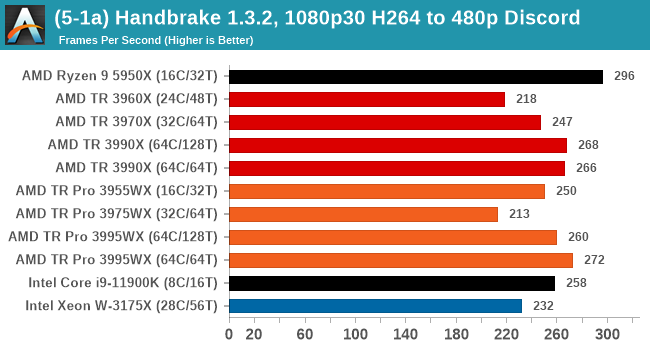
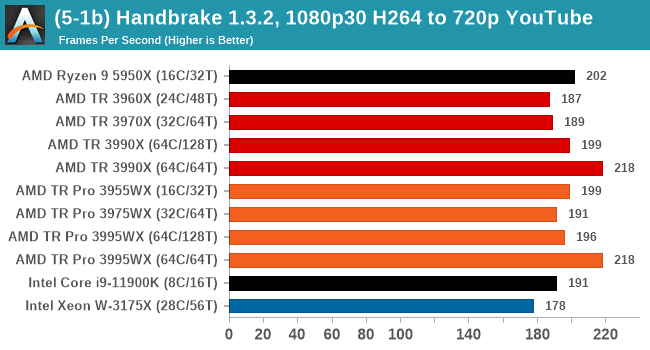
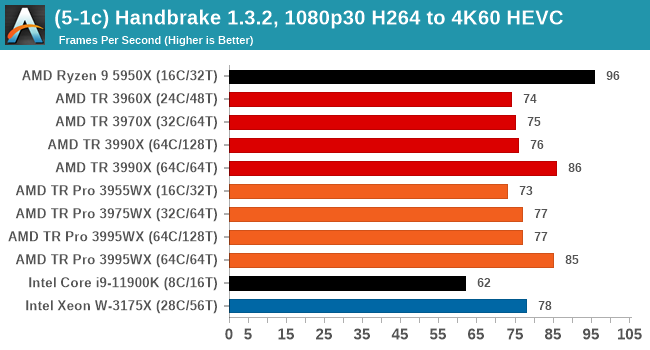
In every situation the R9 5950X does the best or near the best, but HB is one of those tests where running in 64C/64T mode does benefit the result by a good 10%. Otherwise there is little difference between TR and TR Pro.
7-Zip 1900: Link
The first compression benchmark tool we use is the open-source 7-zip, which typically offers good scaling across multiple cores. 7-zip is the compression tool most cited by readers as one they would rather see benchmarks on, and the program includes a built-in benchmark tool for both compression and decompression.
The tool can either be run from inside the software or through the command line. We take the latter route as it is easier to automate, obtain results, and put through our process. The command line flags available offer an option for repeated runs, and the output provides the average automatically through the console. We direct this output into a text file and regex the required values for compression, decompression, and a combined score.
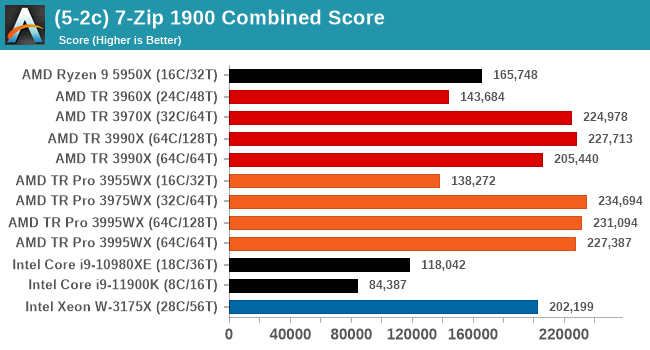
7-zip tends to like memory bandwidth as well as compute, however this test seems to top out at 64 threads, so any processor above that is scoring roughly the same. The 3990X result seems a little low, however.
AES Encoding
Algorithms using AES coding have spread far and wide as a ubiquitous tool for encryption. Again, this is another CPU limited test, and modern CPUs have special AES pathways to accelerate their performance. We often see scaling in both frequency and cores with this benchmark. We use the latest version of TrueCrypt and run its benchmark mode over 1GB of in-DRAM data. Results shown are the GB/s average of encryption and decryption.
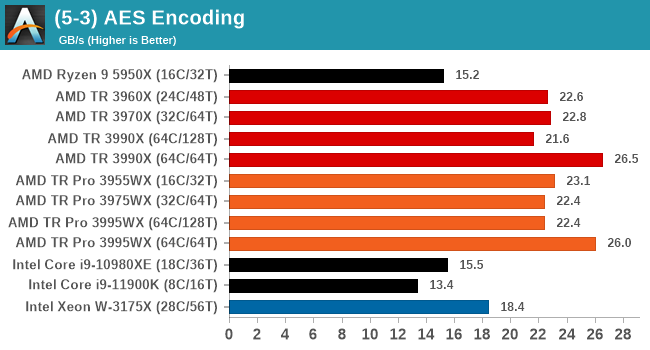
AES does like memory bandwidth, and the 64C/64T setting does best here.
WinRAR 5.90: Link
For the 2020 test suite, we move to the latest version of WinRAR in our compression test. WinRAR in some quarters is more user friendly that 7-Zip, hence its inclusion. Rather than use a benchmark mode as we did with 7-Zip, here we take a set of files representative of a generic stack
- 33 video files , each 30 seconds, in 1.37 GB,
- 2834 smaller website files in 370 folders in 150 MB,
- 100 Beat Saber music tracks and input files, for 451 MB
This is a mixture of compressible and incompressible formats. The results shown are the time taken to encode the file. Due to DRAM caching, we run the test for 20 minutes times and take the average of the last five runs when the benchmark is in a steady state.
For automation, we use AHK’s internal timing tools from initiating the workload until the window closes signifying the end. This means the results are contained within AHK, with an average of the last 5 results being easy enough to calculate.
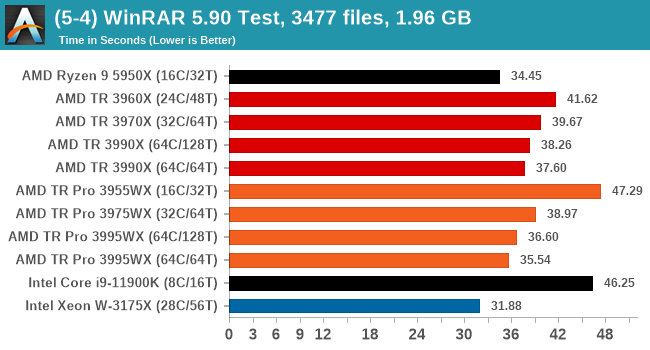
In this test we're looking for the smallest bars representing the lowest time, and 64C/64T has a slight advantage over the full 128T modes. There seems to be no real difference between TR and TR Pro here though - normally WinRAR likes having memory bandwidth, but it seems that there is enough to go around.


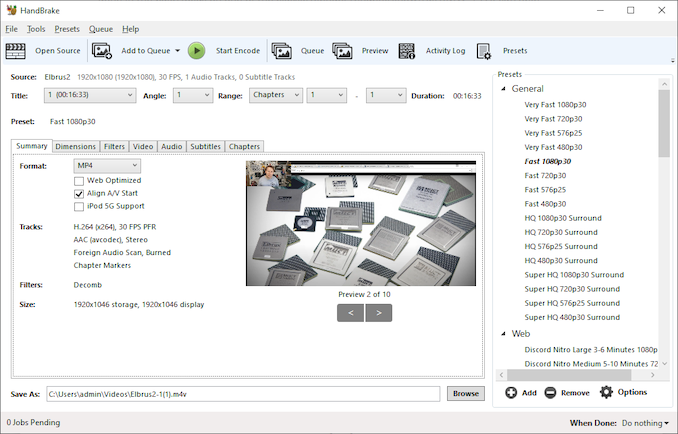
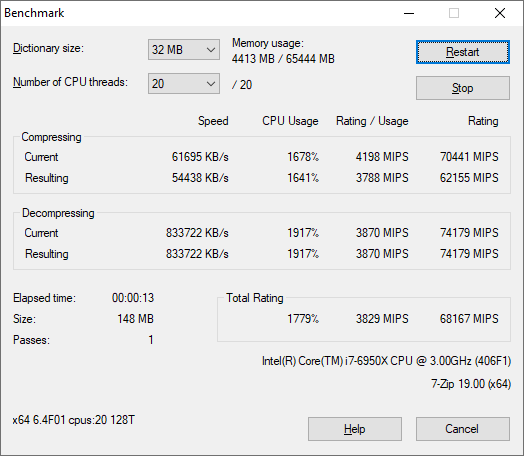
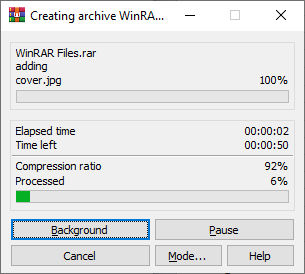








98 Comments
View All Comments
Spunjji - Friday, July 16, 2021 - link
Having seen how modern processors behave with insufficient cooling, Threska's right that it won't get "fried", but you're correct to infer that it would result in unpredictably sub-optimal performance.Anecdotally, I had a friend with a Sandy Bridge system with a cooling issue that he only noticed when he bought a new GPU and ran 3DMark and got unexpectedly low results. The "cooling issue" was that the stock heatsink wasn't even making contact with the CPU heat-spreader; he'd been gaming with the system for 3 years by that point. 😬
serpretetsky - Friday, July 16, 2021 - link
I had to do some thermal shutdown testing on some consumer intel cpu. I forgot which one. Maybe i5/i7 8000 series?With server CPUs this was usually pretty easy, remove fan, and wait for shutdown. With the consumer CPU it kept running. So i completely removed the heatsink, the thing simply downclocked to 800 MHz, and continued running happily with no heatsink. Booted to linux, ran everything great, and no heatsink (actually once it booted to linux I think it even started clocking back up once in a while). I had get a hot-air soldering gun to heat it up till shutdown.
mode_13h - Saturday, July 17, 2021 - link
5-10 years ago, there was a heatsink gasket where you have to get near 100 degrees C to melt the material so it fuses with the heatsink and CPU. I forget the name, but I'm wondering if it's even possible to do that any more.skaurus - Wednesday, July 14, 2021 - link
That's great analysis.Threska - Wednesday, July 14, 2021 - link
It would be nice to see how these MBs do with VFIO since that has considerations most users don't.mode_13h - Wednesday, July 14, 2021 - link
Ian, is the source code for your 3DPM benchmark published anywhere? If not, it would be nice if we could see it and compare the AVX2 path with the AVX-512 one. Also, maybe someone could add support for ARM NEON or SVE.techguymaxc - Wednesday, July 14, 2021 - link
I'm slightly confused by the concluding remarks."Performance between Threadripper Pro and Threadripper came in three stages. Either (a) the results between similar processors was practically identical, (b) Threadripper beat TR Pro by a small margin due to slightly higher frequencies, or (c) TR Pro thrashed Threadripper due to memory bandwidth availability. That last point, (c), only really kicks in for the 32c and 64c processors it should be noted. Our 16c TR Pro had the same memory bandwidth results as TR, most likely due to only having two chiplets in its design."
A and B are observable, but C only proves true in synthetic benchmarks (and Pi calculation). Is there a real-world use-case for the additional memory bandwidth, outside of calculating Pi?
Blastdoor - Wednesday, July 14, 2021 - link
The advantage shows up with multi-threaded SPEC. SPEC is essentially a composite of a suite of real-world tasks. I guess you could call it 'synthetic' due to it being a composite, but the individual tasks don't strike me as 'synthetic.' For example, here's a description of namd: https://www.spec.org/cpu2017/Docs/benchmarks/508.n...techguymaxc - Wednesday, July 14, 2021 - link
Thanks for that info. It would be nice to see the breakdown of individual test results from the SPEC suite.arashi - Saturday, July 17, 2021 - link
Bench